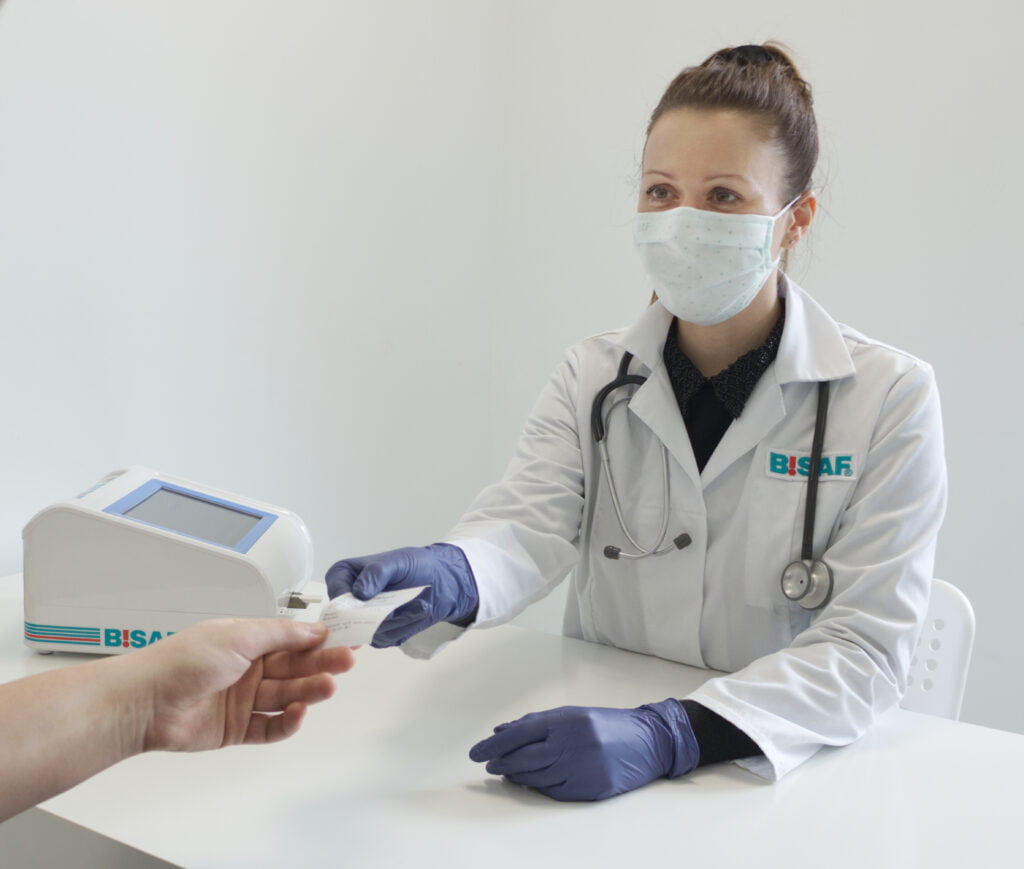Home » Analyzer BV1
Analyzer BV1
The immunofluorescence analyser is an in vitro diagnostic POCT device that provides accurate and rapid quantitative results.
Thanks to its wide range of tests, our analyser allows a much more effective diagnosis than other devices available on the market.
Depending on the test, testing on the analyser can be carried out using different samples, for example plasma, serum or whole blood from a fingertip.
Product designed for professional use


Analyzer BV1
The immunofluorescence analyser is an in vitro diagnostic POCT device that provides accurate and rapid quantitative results.
Thanks to its wide range of tests, our analyser allows a much more effective diagnosis than other devices available on the market.
Depending on the test, testing on the analyser can be carried out using different samples, for example plasma, serum or whole blood from a fingertip.
Product designed for professional use






Properties analyzer BV1
- Maximum sensitivity.
- Autocalibration.
- Rapid results in minutes
LIS/HIS connectivity
Small size, easy to carry. - For professional use.
- Automatic display of the result on the device screen and possibility to print it out.
- Extremely easy to operate.
- Polish language interface.
- Up to 10,000 test results stored in memory.
- Possibility to connect a mouse and keyboard due to the availability of two USB ports
- Other communication ports available on the analyser: DC – IN/ RJ45/ USB B/ CAN-IN/ CAN-OUT/ RS232
| Nr model | VMFIA1001 |
| Excitation LED light source | LED |
| Excitation spectrum |
Centre wavelength λ0 = 365nm |
| Absorption spectrum |
Centre wavelength λ1 = 610nm |
| Test sample | Whole blood, serum, plasma, urine and faeces |
| Work environment | Operating system Android5.1.1 |
| Interfejs | Serial port, USB, Ethernet |
| In-builder printer | Thermal print |
| Size | 245x270x160mm±5mm |
| Weight | 2000g±200g |
| Repeatability | CV≤15% |
| Stability | CV≤15% |
Shortened diagnostics
from several days to 15 minutes
What tests can you perform with our analyzer?
- Test used in early detection of: bacterial infections, viral infections, fungal infections, parasitic infections and – autoimmune disease
- Normal: <5 mg/l
- A high CRP level (40-100 mg/l) or greater than 100 mg/l may indicate a bacterial infection and warrant antibiotic treatment. Bacterial infection and the appropriateness of antibiotic treatment. Urgent consultation with a doctor.
- Levels more than 1,000 times normal values occur in myocardial infarction
myocardial infarction, trauma, following surgical intervention and in the case of malignant tumours
malignant tumours
- Test used in the diagnosis of inflammatory conditions
Standard: - <1mg/l – low risk
- 1-3 mg/l – medium risk,
- >3 mg/l – high risk
- It is a more accurate test than classical CRP because the concentration of hs CRP
in plasma increases even with a small increase in inflammatory substances
- Diabetes screening test.
- Normal: <5.7%.
- Pre-diabetic state: 5,7 – 6,4%.
- Diabetes mellitus: >6.5%.
- Test used in the diagnosis of coagulation disorders:
venous and arterial thrombosis, pulmonary embolism, disseminated coagulation syndrome
disseminated intravascular coagulation syndrome and differentiation of hyperfibrinolysis. - Standard: 500 µg/l.
- Test to detect cardiac injury, skeletal muscle damage, shock, renal failure and burns.
- Reference range: 0.009-0.4 μg/L (but dependent on many factors).
- Test for the detection of thyroid disorders.
- Reference range: 0.2 – 4.5 IU/l.
- Lower limit – hyperthyroidism.
- Above 4.5 mj – hypothyroidism.
- Heart failure test: ischaemic heart disease, left ventricular failure, acute coronary syndromes.
- Reference range Under physiological conditions, BNP levels are higher in women than in men and irrespective of gender, increases with age, which is explained by increasing left ventricular stiffness ventricle.
- Steroidal antigen test = marker of prostatic hypertrophy
Norms: - 40 – 49 yrs. 1.5 ng/ml.
- 50 – 59 years of age. 2,5.
- 60 – 69 years of age 4,5.
- 70 – 79 years of age 7,5.
- Test can confirm pregnancy 6-10 days after conception.
- In pathological cases hCG is secreted by various types of tumours.
- Norm depends on woman’s age and week of pregnancy.
- 6-7 weeks of pregnancy: 4000-100200.
- 7-12 week of pregnancy: 11500-289000.
- 12-16 week of pregnancy: 18300-137000.
- 16-29 week of pregnancy: 1400-53000.
- Test for the diagnosis of thyroid disease.
- Normal: 2.25 to 6.0 pmol/L (1.5-4.0 ng/L).
- Test for diagnosing thyroid disease.
- Normal: 10-25pmol/l (8-20ng/l).
- Test used in the diagnosis of bacterial infections
- Plasma procalcitonin levels help determine the intensity and degree of infection
Normal: - <0.5 ng/ml: Partial bacterial or viral infection, excluding systemic infection.
- 0.5 – 2.0 ng/ml: May be systemic infection and moderate risk of severe infection.
- 2.0 – 10.0 ng/ml: There may be systemic infection and high risk of severe infection.
- >10 ng/ml: Severe systemic infection.
- Diagnostic test: cancer, neurodegenerative diseases, lung diseases, bacterial infections, osteoporosis, thrombosis, obstetric complications, mental disorders and metabolic diseases
- Normal: 10.7 – 2.4 mg/l
- Test used to detect inflammation (including arteriosclerosis, rheumatoid arthritis, Alzheimer’s disease, Crohn’s disease.
What benefits will you notice while using our BV1 analyzer?
As a POCT device, it allows examinations to be carried out directly at the facility, making logistics much easier.
It allows the previously several-day diagnostic process to be shortened to as little as 15 minutes.
By providing immediate diagnostics, it will enable more patients to be served in less time, reducing queues and increasing the efficiency of the facility.
It will eliminate unpleasant situations such as lost or misplaced samples in the laboratory.
Facilitates diagnostics by performing the test in the facility and not having to refer patients to the laboratory.
Uses the latest technology that meets market expectations.







